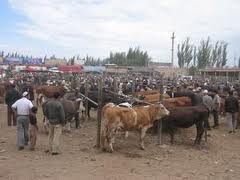In agriculture, fodder or animal feed is any foodstuff that is used specifically to feed domesticated livestock such as cattle, goats, sheep, horses, chickens and pigs. Most animal feed is from plants but some is of animal origin. "Fodder" refers particularly to food given to the animals (including plants cut and carried to them), rather than that which they forage for themselves (see forage). It includes hay, straw, silage, compressed and pelleted feeds, oils and mixed rations, and also sprouted grains and legumes.
The worldwide animal feed industry consumed 635 million tons of feed (compound feed equivalent) in 2006, with an annual growth rate of about 2%. The use of agricultural land to grow feed rather than human food can be controversial; some types of feed, such as corn (maize), can also serve as human food, while others such as grass cannot. Some agricultural by-products which are fed to animals may be considered unsavory by human consumers.
In the past, bovine spongiform encephalopathy (BSE or "mad cow disease") spread through the inclusion of ruminant meat and bone meal in cattle feed due to prion contamination. This practice is now banned in most countries where it has occurred. Some animals have a lower tolerance for spoiled or moldy fodder than others, and certain types of molds, toxins, or poisonous weeds inadvertently mixed into a food source may cause economic losses due to sickness or death of the animals.
Fodder in the form of sprouted grains and legumes can be grown in a small-scale environment. Sprouted grains can greatly increase the nutritional value of the grain compared with feeding the "raw" (ungerminated) grain to stock. Sprouted barley and other cereal grains can be grown hydroponically in a carefully controlled environment. Under hydroponic conditions, sprouted fodder at 150 mm tall with a 50 mm root mat is at its peak for animal feed.







No comments:
Post a Comment